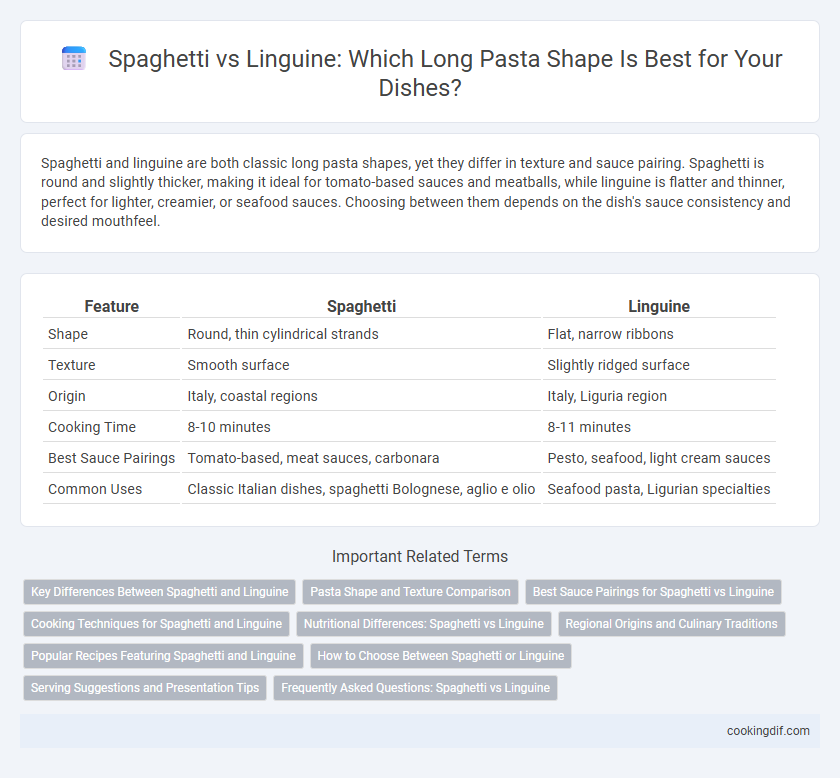Spaghetti and linguine are both classic long pasta shapes, yet they differ in texture and sauce pairing. Spaghetti is round and slightly thicker, making it ideal for tomato-based sauces and meatballs, while linguine is flatter and thinner, perfect for lighter, creamier, or seafood sauces. Choosing between them depends on the dish's sauce consistency and desired mouthfeel.
Table of Comparison
| Feature | Spaghetti | Linguine |
|---|---|---|
| Shape | Round, thin cylindrical strands | Flat, narrow ribbons |
| Texture | Smooth surface | Slightly ridged surface |
| Origin | Italy, coastal regions | Italy, Liguria region |
| Cooking Time | 8-10 minutes | 8-11 minutes |
| Best Sauce Pairings | Tomato-based, meat sauces, carbonara | Pesto, seafood, light cream sauces |
| Common Uses | Classic Italian dishes, spaghetti Bolognese, aglio e olio | Seafood pasta, Ligurian specialties |
Key Differences Between Spaghetti and Linguine
Spaghetti is a round, thin pasta strand that cooks quickly and holds light sauces well, making it ideal for classic tomato or olive oil-based dishes. Linguine is flatter and slightly wider, providing a larger surface area that pairs excellently with thicker, creamier sauces and seafood. The textural difference influences sauce absorption and mouthfeel, defining their distinct culinary uses.
Pasta Shape and Texture Comparison
Spaghetti features a round, thin shape that delivers a firm bite and smooth texture, ideal for light sauces like marinara or aglio e olio. Linguine is flatter and slightly wider, offering a broader surface area that holds thicker sauces such as pesto or clam sauce more effectively. Texture-wise, linguine provides a chewier mouthfeel compared to the more delicate snap of spaghetti strands.
Best Sauce Pairings for Spaghetti vs Linguine
Spaghetti pairs exceptionally well with classic tomato-based sauces like marinara or Bolognese due to its round, thin shape that holds these smoother sauces effectively. Linguine's slightly flatter, wider profile allows it to better capture lighter, more delicate sauces such as clam sauce, pesto, or creamy Alfredo. Choosing the right sauce enhances flavor absorption, making spaghetti ideal for robust, chunky sauces while linguine excels with seafood or herb-infused blends.
Cooking Techniques for Spaghetti and Linguine
Spaghetti requires a rapid boil in salted water to achieve a firm al dente texture, typically cooked for 8-10 minutes, allowing it to maintain its characteristic round shape. Linguine demands slightly more attention during cooking, as its flat and thin profile requires gentle stirring to prevent clumping and ensures even cooking, usually done within 9-11 minutes. Both pasta shapes benefit from finishing in a sauce pan with a splash of reserved pasta water to enhance flavor absorption and texture cohesion.
Nutritional Differences: Spaghetti vs Linguine
Spaghetti and linguine are both long pasta shapes with similar calorie content, but linguine tends to have a slightly higher carbohydrate and protein content per serving due to its wider surface area. Both types provide essential nutrients like B vitamins and iron, though whole wheat versions enhance fiber intake significantly. Choosing between spaghetti and linguine nutritionally depends more on the specific brand and whether the pasta is made from refined or whole grain flour.
Regional Origins and Culinary Traditions
Spaghetti originates from Southern Italy, especially Naples, where it is traditionally served with tomato-based sauces like marinara or seafood. Linguine has its roots in Liguria, a coastal region in Northern Italy, and is commonly paired with pesto or light, creamy sauces featuring seafood. These regional differences reflect distinct culinary traditions, with spaghetti embodying hearty, robust flavors and linguine emphasizing delicate, herbaceous combinations.
Popular Recipes Featuring Spaghetti and Linguine
Spaghetti and linguine both excel in Italian cuisine, with spaghetti prominently featured in recipes like Spaghetti Carbonara, Spaghetti Bolognese, and Spaghetti Aglio e Olio, showcasing its versatility with rich sauces and garlic-infused oil. Linguine pairs exceptionally well with seafood, starring in popular dishes such as Linguine alle Vongole (clam sauce), Linguine al Pesto, and creamy Alfredo variations, allowing its slightly wider shape to hold delicate, creamy, or broth-based sauces. Both pasta shapes enhance classic Italian flavors, with spaghetti favored for hearty, robust recipes and linguine preferred for lighter, more sauce-coated preparations.
How to Choose Between Spaghetti or Linguine
Spaghetti features a round, thin shape that pairs well with light, smooth sauces like marinara or olive oil-based dressings, while linguine's flatter, broader form holds up better to thicker, creamier sauces such as Alfredo or pesto. Consider the sauce consistency and desired texture when choosing between spaghetti and linguine to optimize flavor absorption and mouthfeel. For dishes with seafood or delicate ingredients, linguine's surface area provides enhanced sauce clinging, whereas spaghetti suits minimalist pasta presentations.
Serving Suggestions and Presentation Tips
Spaghetti pairs well with simple tomato-based sauces or light olive oil dressings that allow its classic shape to twirl easily on a fork, making it ideal for casual dining presentations. Linguine's slightly flatter shape holds more sauce, making it perfect for seafood-based dishes like clam sauce or creamy pesto, enhancing both flavor absorption and visual appeal. For elegant plating, twirl spaghetti into neat nests or layer linguine with vibrant ingredients to showcase texture and color contrast on the plate.
Frequently Asked Questions: Spaghetti vs Linguine
Spaghetti is a round, thin pasta shape commonly used in traditional Italian dishes like spaghetti carbonara and spaghetti bolognese, while linguine is a flat, narrow pasta that pairs well with seafood and creamy sauces due to its slightly broader surface area. Frequently asked questions often revolve around which pasta holds sauce better; linguine's flat shape allows it to cling to thicker sauces more effectively, whereas spaghetti works well with lighter tomato or olive oil-based sauces. Both pastas cook quickly, typically in about 8-12 minutes, making them versatile staples for various recipes depending on the desired texture and sauce pairing.
Spaghetti vs linguine for long pasta shapes Infographic

 cookingdif.com
cookingdif.com